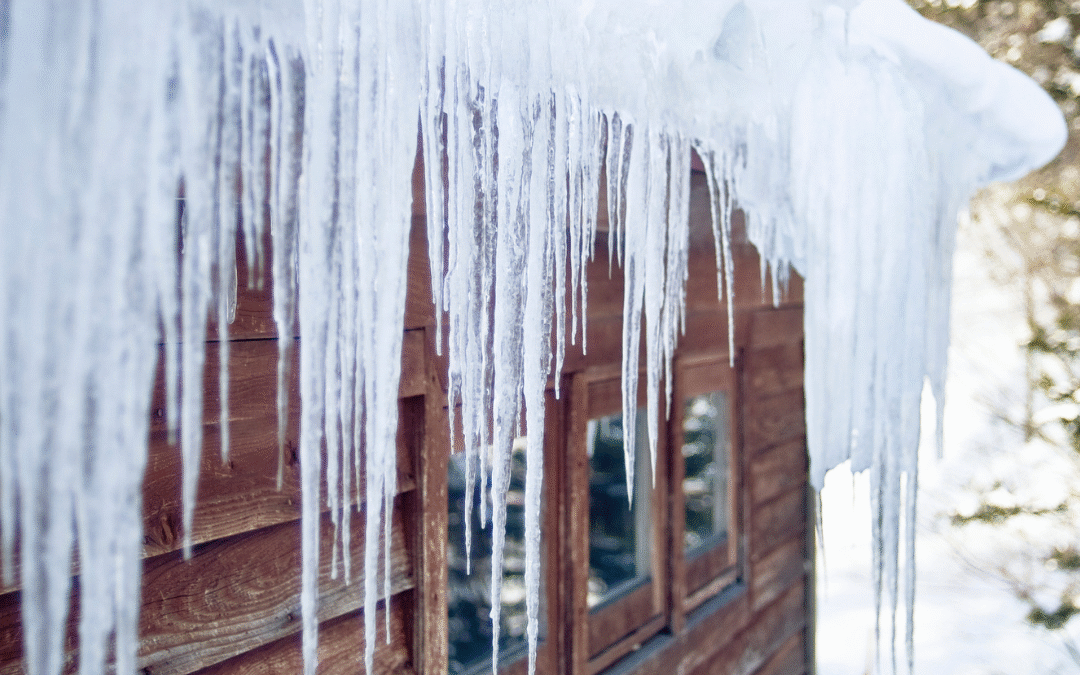If you’ve ever noticed thick ridges of ice forming along the edge of your roof after a heavy snow in Northern Kentucky or Greater Cincinnati, you’ve likely seen an ice dam in action. They might look harmless from the ground, but ice dams can quietly cause major water damage to your roof, attic, walls, and insulation.
Understanding how they form—and how to prevent them—can save you thousands in roofing and water damage repairs. Let’s walk through what every homeowner needs to know.
Table of Contents
What Is an Ice Dam?
An ice dam is a buildup of ice that forms along the edge of your roof, typically after a snowfall followed by freezing temperatures. While the snow on your roof may start to melt due to heat escaping from your attic, that meltwater runs down the roof toward the eaves, where it refreezes—because those edges stay colder.
Over time, this frozen barrier grows thicker, trapping water behind it. That standing water has nowhere to go, so it often seeps under your shingles and into your home.
What Causes Ice Dams to Form?
Ice dams are a result of uneven roof temperatures, usually caused by a combination of:
1. Poor Attic Insulation
Warm air from inside your home rises into the attic. If your attic is poorly insulated, it causes the underside of your roof to warm up, melting the snow unevenly.
2. Inadequate Attic Ventilation
Without proper airflow, warm air becomes trapped in the attic. This raises the roof temperature, especially toward the peak, while the eaves stay cold—perfect conditions for ice dam formation.
3. Clogged or Blocked Gutters
When gutters are filled with leaves or debris (often from fall), meltwater can’t drain properly. That water pools and freezes at the roof’s edge, contributing to dam formation.
4. Sudden Warmups Followed by Freezes
In the Greater Cincinnati area, it’s common to see a thaw-freeze cycle during winter. These fluctuating temperatures melt snow quickly—but if it refreezes overnight, ice dams can form fast.
The Hidden Damage Ice Dams Can Cause
While you may not notice the effects of an ice dam right away, the water that backs up behind it can infiltrate your roof in just a few hours.
Common types of damage caused by ice dams:
- Water leaks in ceilings or walls
- Damaged insulation, reducing energy efficiency
- Mold growth in attics or behind drywall
- Warped wood or rotting roof decking
- Sagging ceilings and peeling paint
If left untreated, ice dam damage can spread beyond the roof, affecting your home’s structure and indoor air quality. This often leads to costly insurance claims—or out-of-pocket repairs if the damage is deemed preventable.
How to Prevent Ice Dams on Your Roof
Fortunately, there are several proven steps homeowners can take to stop ice dams before they start.
1. Upgrade Attic Insulation
Proper insulation helps keep warm air inside your living space—not your attic. This keeps the roof temperature more consistent and reduces uneven melting.
2. Ensure Adequate Attic Ventilation
Good ventilation allows cold air to circulate in your attic, maintaining a uniform temperature across the roof. This can be achieved with soffit vents, ridge vents, or gable vents.
3. Clean Your Gutters Before Winter
Make sure gutters and downspouts are free of debris. Blocked drainage can quickly lead to pooling meltwater and ice buildup.
4. Install Roof Heat Cables
In trouble spots where insulation and ventilation upgrades aren’t enough, heat cables can help melt snow and ice before a dam forms.
5. Use a Roof Rake After Heavy Snowfalls
Removing excess snow from your roof’s edge (using a long-handled roof rake from the ground) helps prevent the initial melting-refreezing cycle that leads to ice dams.
What to Do If You Have an Ice Dam
If you notice icicles forming or water stains on your ceiling during the winter, it’s important to act quickly. Avoid trying to chip away the ice yourself—it can damage shingles or cause injury.
Instead:
- Contact a local roofing professional for a safe removal
- Use fans in the attic to lower temperatures temporarily
- Place a calcium chloride ice melt sock behind the dam (never use rock salt, which damages roofing materials)
At A+ Services, we provide emergency roof leak repair, ice dam removal, and long-term solutions like attic insulation upgrades and ventilation improvements across Northern Kentucky and Greater Cincinnati.
Protect Your Roof Before Ice Dams Strike
Ice dams aren’t just a cosmetic issue—they’re a warning sign that your roof and attic may need attention. Whether you’re seeing water damage already or want to prevent it before winter hits, the best time to act is now.
Why choose A+ Services?
- Expert roof inspections and storm preparation
- Gutter repair and maintenance
- Emergency response for roof leaks and winter water damage
- Transparent, flat-rate pricing with no surprise fees
Don’t wait for a roof leak to ruin your winter. Contact A+ Services today to schedule your winter roofing inspection and ice dam prevention plan.
Follow us for more seasonal tips:
Facebook | Instagram | YouTube | Nextdoor
Stay proactive, stay protected—and keep winter outside where it belongs.

